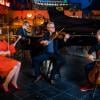
If you’ve taken singing lessons, you may well own a yellow-covered collection called 24 Italian Songs and Arias, which contains a tearful solo by Claudio Monteverdi, “Lasciatemi morire” (Let me die). Performances of the song are well represented on YouTube, at various degrees of expertise. Much less well known is Monteverdi’s earlier version of the composition — a madrigal for five voices.
On Oct. 12 at Cal Performances, we got a chance to hear “Lasciatemi” in its original ensemble form and in its original context as part of Monteverdi’s now mostly lost opera L’Arianna. The opera dramatizes the mythical plight of Ariadne, who’s been abandoned on a desert island by her cad of a lover, the hero Theseus. L’Arianna must have seemed something of a downer in its premiere as entertainment for a 1608 royal wedding.
Saturday’s concert in Zellerbach Hall featured the indomitable viola da gamba player Jordi Savall, along with five excellent singers — members of La Capella Reial de Catalunya — and a small group of fellow viol players and a lutenist — members of Savall’s instrumental ensemble Hespèrion XXI.

Through the 1500s, Italian composers had developed madrigal composition to extraordinary heights, so it’s no surprise that Monteverdi used the form to convey the rich sonorities and expressive range of L’Arianna.
For anyone accustomed to modern opera, where one singer represents one character, it may seem strange to hear the sorrows of Ariadne sung by five different singers — women and men. But in the hands of a skilled ensemble like Savall’s, the effect is startlingly powerful. The music piles phrases on top of each other, which are interrupted and then blended, which diverge and then cadence, making for an exponential increase in meaning over what a solo singer could do. The woe of the abandoned woman becomes not that of a single individual but something that transcends gender, vocal range, and even personality.
“Lasciatemi” and three similar pieces are unfortunately all we have left of that lost opera. In inspired and technically dazzling performances on Saturday, these selections were not so much fragments as an intensely compressed portrait of the sorrow and anger that come with betrayal and abandonment. Fittingly, the program was titled “The Tears and the Fire of the Muses.”
The fire was mostly in the vocal numbers, but interpolated instrumental pieces added yet more tears to the mix. The excellent ensemble of viols and theorbo (a greatly expanded form of lute) gave moving performances of music that revels in the depiction of sorrow. John Dowland, whose music often matches his “dolorous” name (pronounced dough-land), was a master of dissonances and chromaticisms that project a wordless but powerful grief. Other viol pieces on the program were by Dowland’s English contemporary Anthony Holborne and the 17th-century German composer Samuel Scheidt.
Even outside of opera, Monteverdi’s compositions are dramatic, perhaps none more so than “Lagrime d’amante al sepolcro dell’amata” — “the Sestina,” as it’s known among singers — six linked madrigals depicting “the tears of the lover at the tomb of the beloved.” There was indeed “un mar di pianto” (a sea of tears), but the fires of anger also burned, especially in a climax as fiery as one could imagine in any grand opera.
Things calmed down a little for the last section of the program, a lovely pastoral scene about two lovers whose relationship is a good deal less stormy than Ariadne’s. Monteverdi’s inventive music for this Renaissance rom-com, Tirsi e Clori, is expressive and varied, especially when the score sets such overwrought metaphors as “she wounded me with a kiss.”

The “Ballo” that concluded the program was a vivacious wedding dance, rivaling Gilbert and Sullivan in its virtuosic patter-song vibe. The viols did their best to add to the party atmosphere, but the piece needed some livelier instrumentation (cornetti? recorders? drums?) to bring out all the whirling delight in the poem and the music. Overall, the theorbo was played too softly for the admittedly daunting acoustics of Zellerbach.
As usual, the Berkeley audience gave the group an enthusiastic ovation. Two encores from 18th-century Peru — one in the Indigenous Quechua language — brought the concert to a close, Savall dazzling with his inventive and virtuosic viol playing.




